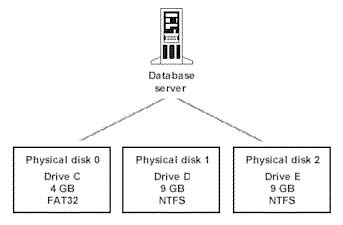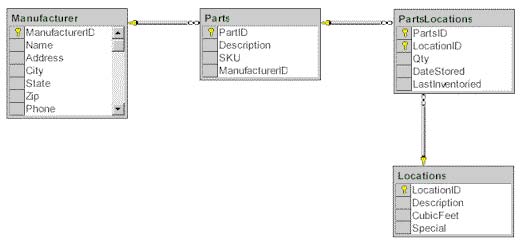the query transaction rate
numeric data versus character data
extent size
the cardinality of the candidate columns
prefetch size
第1题:
You are the administrator of a SQL Server 2000 computer. The server is configured as shown in the Database Server Configuration exhibit.

You need to create a new database named Inventory. Employees in your company will use the Inventory database to track inventory data. Users will require immediate responses to queries that help them locate where parts are stored. The tables in the database will be configured as shown in the Database Schema exhibit.

The database will consume 14 GB of disk space. You must configure the data files and transaction log to accelerate query response time.
Which two courses of action should you take? (Each correct answer represents part of the solution. Choose two.)
A. On drive C, create a transaction log.
On drive D, create a data file in the PRIMARY filegroup.
On drive E, create a data file in the SECONDARY filegroup.
B. On each drive, create a transaction log.
On each drive, create a data file in the PRIMARY filegroup.
C. On drive D, create a transaction log.
On drive E, create a data file in the PRIMARY filegroup.
D. On the PRIMARY filegroup, create all tables and all indexes.
E. On the PRIMARY filegroup, create all tables. On the SECONDARY filegroup, create all indexes.
F. On the PRIMARY filegroup, create the Parts table and its indexes.
On the SECONDARY filegroup, create all other tables and their indexes.
第2题:
By mistake, you ran the batch job (for updating the BILL_DETAILS table) twice. You are not sure which rows in the BILL_DETAILS table were affected. You need to identify: a) a list of changes made along with the transaction identifier of each change b) the necessary SQL statements to undo the erroneous changes Which option would you choose?()
第3题:
You are the administrator of a SQL Server 2000 database. You import a table of geographic information from a Microsoft access database into a SQL Server 2000 database. The table has 12,000 rows. Each row averages 5,000 bytes. The table contains lockup data that does not change.
You want to minimize the size of the data file and the time required to back up the data. Which two actions should you take? (Each correct answer presents part of the solution. Choose two)
A. Create a 60-MB data file named geography.ndf
B. Create a 95-MB data file named geography.ndf
C. Create a 60-MB data file named geography.mdf
D. Create a 95-MB data file named geography.mdf
E. Place the table in the PRIMARY filegroup.
F. Place the table in a new filegroup named LOCATION.
第4题:
Which two statements about Flashback Query are true?()
第5题:
You are working in an online transaction processing (OLTP) environment. You realize that the salary for an employee, John, has been accidentally modified in the EMPLOYEES table. Two days ago, the data was in the correct state. Flashback logs generated during last two days are available in the flash recovery area. Which option would you choose to bring the data to the correct state while ensuring that no other data in the same table is affected?()
第6题:
When a database administrator chooses the dimensions for an MDC table, which two characteristics should beconsidered?()
第7题:
You work as a database administrator for Certkiller .com. In your transaction application, you have scheduled a job to update the optimizer statistics at05:00 pm every Friday. The job has successfully completed. Which three pieces of information would you check to confirm that the statistics have been collected?()
第8题:
You are the administrator of two Microsoft Windows 2000 advanced server computers. On these servers, you are configuring a database that will store accounting information for your company.
The data must be available at all times. Interruptions in data connectivity should not last longer than five minutes. Any changes to the database should not require you to reconfigure the client computers.
How should you configure the database?
A.Configure the database on the two servers as a SQL Server 2000 cluster.
B.Configure the database on one server, and then configure a standby database on the second server.
C.Configure the database on each server. Use Microsoft Distributed Transaction Coordinator to keep the two servers perfectly synchronized.
D.Configure the database as a federated database, and then partition half the data on each server.
第9题:
You are working on an Oracle Database 10g database. For which purposes would you use the Flashback Transaction Query feature? ()
第10题:
You work as a database administrator at Certkiller .com. You are working in an online transaction processing (OLTP) environment. You realize that the salary for an employee, John, has been accidentally modified in the EMPLOYEEStable. Two days ago, the data was in the correct state. Flashback logs generated during last two days are available in the flash recovery area. Which option would you choose to bring the data to the correct state while ensuring that no other data in the same table is affected?()